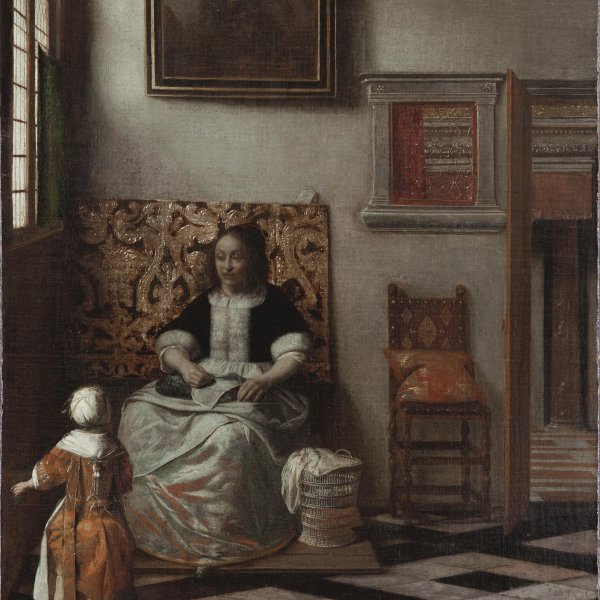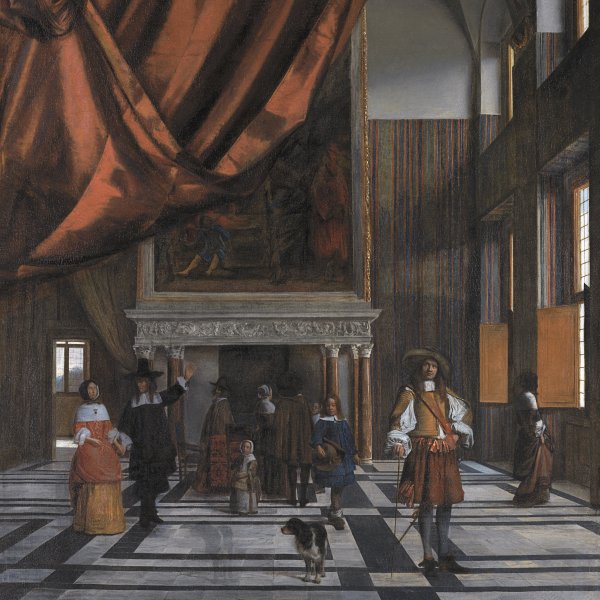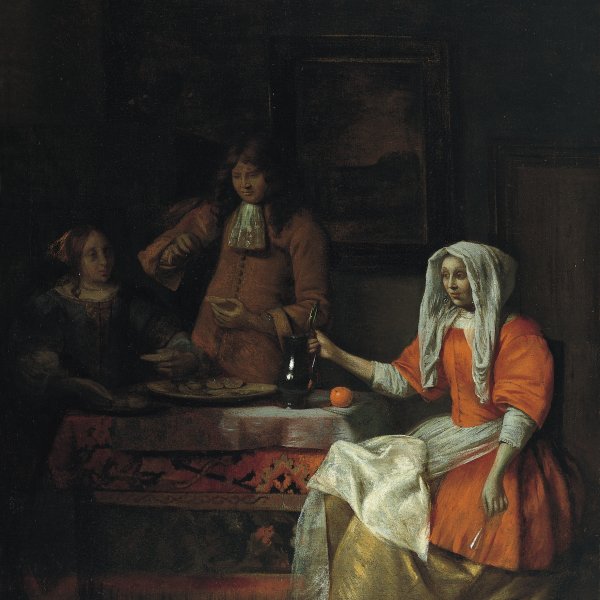Pieter Hendricksz. de Hooch
Rotterdam, 1629-Amsterdam, 1684
Pieter de Hooch was born in Rotterdam in 1629. According to the biographer of Dutch painters, Arnold Houbraken, he trained with the landscape painter Nicolaes Berchem, although that master’s style is not evident in his early work. De Hooch’s early scenes of taverns and soldiers are painted with strong contrasts of light and reflect the style of Ludolf de Jongh, an artist active in De Hooch’s native city. Among his first known works is The Backgammon layers (National Gallery of Ireland, Dublin).
In 1652 De Hooch is documented in Delft where he married the sister of his friend the painter Hendrick van der Burch and where he produced his most important and best paintings. In 1653 the artist is documented as a painter and employee of Justus de la Grange, an art dealer who lived in Delft and Leiden. In 1655 and 1657 his name appears in the painters’ guild of Saint Luke in Delft. During this period De Hooch modified his subject-matter and focused on domestic scenes of middle-class interiors including a series of masterpieces such as The Pantry (Rijksmuseum, Amsterdam), Servant and young Boy in a Courtyard (National Gallery, London), and Man smoking and Woman drinking in a Courtyard (Mauritshuis, The Hague). Around 1660 De Hooch moved to Amsterdam where he is documented in 1661 and 1672. During this period his style became more descriptive and he set his scenes in luxurious settings with a wealth of decorative elements. These works, however, lack the subtlety of his Delft phase. At the end of his career, influenced by the new taste for French art and culture, De Hooch began to locate his figures in the marble rooms of the new Amsterdam Town Hall, which offered more opportunity for grandiose settings than his previous bourgeois interiors. Dating from his Amsterdam period are The Clothes Cupboard (Rijksmuseum, Amsterdam), and The Minuet (Statens Museum for Kunst, Copenhagen). De Hooch died in a hospice in 1684. He was one of the finest of the Dutch genre painters and his work has always been associated with the city of Delft where he produced his best paintings. De Hooch had no documented pupils but his work exercised a notable influence on contemporary painters including Pieter Janssens Elinga, Jacobus Vrel and Esaias Bourse.
In 1652 De Hooch is documented in Delft where he married the sister of his friend the painter Hendrick van der Burch and where he produced his most important and best paintings. In 1653 the artist is documented as a painter and employee of Justus de la Grange, an art dealer who lived in Delft and Leiden. In 1655 and 1657 his name appears in the painters’ guild of Saint Luke in Delft. During this period De Hooch modified his subject-matter and focused on domestic scenes of middle-class interiors including a series of masterpieces such as The Pantry (Rijksmuseum, Amsterdam), Servant and young Boy in a Courtyard (National Gallery, London), and Man smoking and Woman drinking in a Courtyard (Mauritshuis, The Hague). Around 1660 De Hooch moved to Amsterdam where he is documented in 1661 and 1672. During this period his style became more descriptive and he set his scenes in luxurious settings with a wealth of decorative elements. These works, however, lack the subtlety of his Delft phase. At the end of his career, influenced by the new taste for French art and culture, De Hooch began to locate his figures in the marble rooms of the new Amsterdam Town Hall, which offered more opportunity for grandiose settings than his previous bourgeois interiors. Dating from his Amsterdam period are The Clothes Cupboard (Rijksmuseum, Amsterdam), and The Minuet (Statens Museum for Kunst, Copenhagen). De Hooch died in a hospice in 1684. He was one of the finest of the Dutch genre painters and his work has always been associated with the city of Delft where he produced his best paintings. De Hooch had no documented pupils but his work exercised a notable influence on contemporary painters including Pieter Janssens Elinga, Jacobus Vrel and Esaias Bourse.







